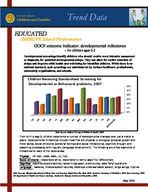Trend Data
EDUCATED
- IMPROVE School Performance GOCF outcome indicator: developmental milestones
for children ages 0-5
Developmental screenings identify children who should receive more intensive assessment or diagnosis, for potential developmental delays. They can allow for earlier detection of delays and improve child health and well-being for identified children. While there is no national standard, such screenings are administered by various healthcare professionals, community organizations, and schools.
Children Receiving Standardized Screening for Developmental or Behavioral problems, 2007
30% 25% 20% 15% 10% 5% 0%
Data Source: National Survey of Children's Health, 2007.
From birth to age 5, children experience a number of developmental changes over just a matter a years. Developmental milestones include those that are physical or biological (physical growth and motor skills), social emotional (personal feelings and social interactions), cognitive (thought and reasoning processes), and linguistic (language development). The following are a few examples of milestones for each of the listed areas: Physical : roll over, crawl, walk, run, hop Social emotional : responsive smile, responsive to name, says "no," affectionate Cognitive : explores objects tactilely, takes things apart, pretend play, asks "why" questions Language : babbles, imitates speech sounds, develops understandable speech, sings songs, rhymes
Data Sources: Georgia Department of Early Care and Learning: Bright From the Start, 2010. American Academy of Pediatrics, 2010. Born Learning, 2010. US Department of Health and Human Services, Centers for Disease Control and Prevention, 2010.
May 2010
Trend Data
The American Academy of Pediatrics suggests that you tell your doctor if you notice any of the following during your baby's second, third, and
fourth weeks of life:
~ Sucks poorly or feeds slowly. ~ ~ Doesn't blink in bright light. ~ ~ Doesn't focus and follow movement of a nearby object. ~ ~ Rarely moves arms and legs, seems stiff. ~ ~ Seems very loose in the limbs or floppy. ~ ~ Lower jaw trembles constantly, even when the baby ~
is not crying or excited. ~ Doesn't respond to loud sounds. ~
In the United States, 17% of children have a developmental or behavioral disability, and many children have delays in language or other areas, impacting school readiness. Less than 50% of these children are identified as having a problem before
starting school.
